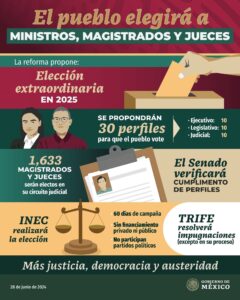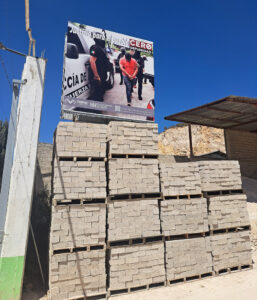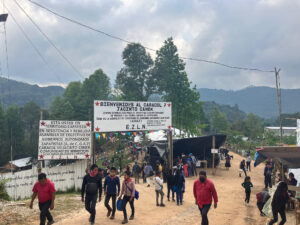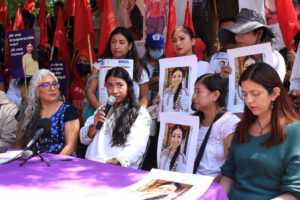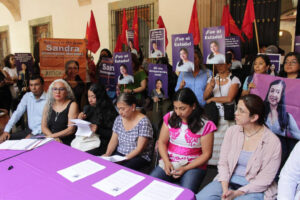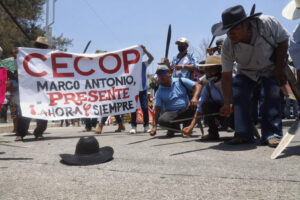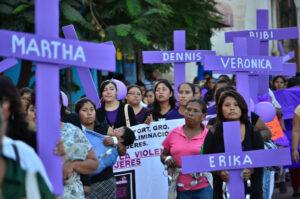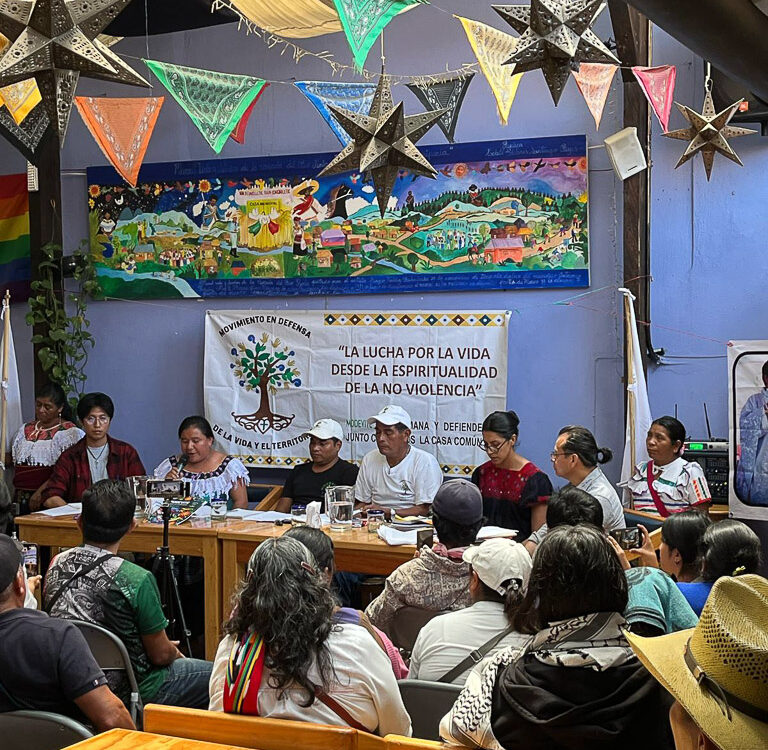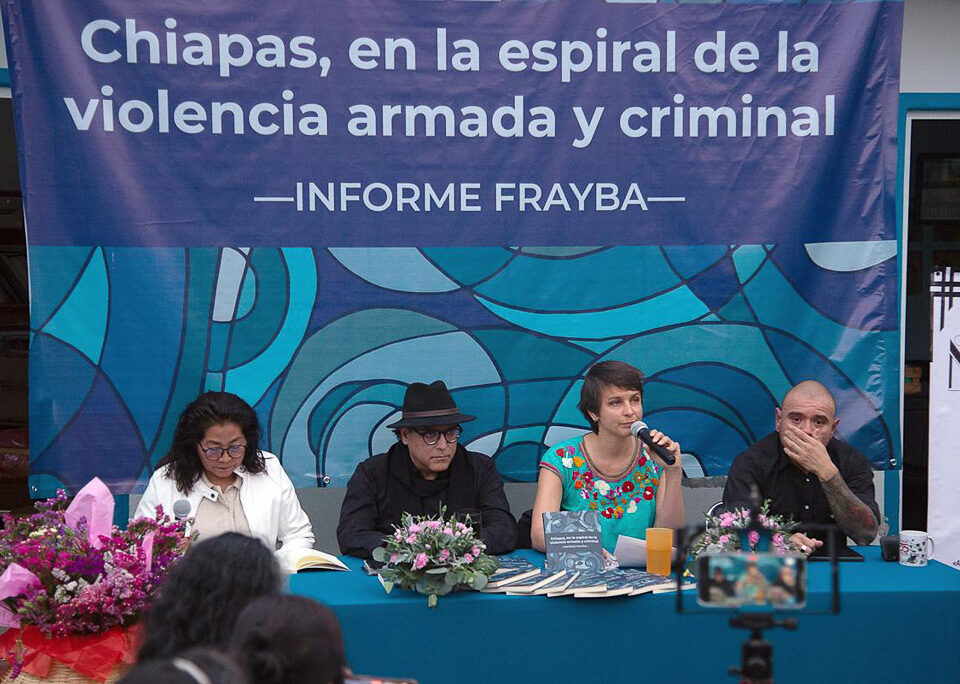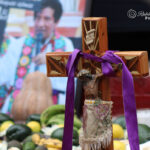
SIPAZ Activities (Mid-November 2024 to mid-February 2025)
08/03/2025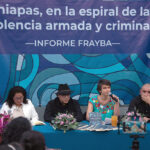
FOCUS: “Chiapas in the Spiral of Armed and Criminal Violence”
11/06/2025
T he relationship between Mexico and the United States has historically been complex, with strong aspects of cooperation and interdependence, but also with trade tensions and sovereignty disputes that have been particularly significant since Donald Trump returned to the presidency in January, 2025.
In February, the Mexican Senate approved a constitutional reform seeking to strengthen the principles of non-intervention and non-interference. The proposal was submitted by President Claudia Sheinbaum after the Trump administration designated the Mexican cartels of Sinaloa, Jalisco New Generation, the Gulf Cartel, the Northeast Cartel, Nueva Familia Michoacana, and the United Cartels as terrorist organizations, raising concerns about possible intervention by US agents on Mexican soil. It was stipulated that “interventions, interferences, or any act from abroad” will not be accepted, particularly “coups d’état, interference in elections, or the violation of Mexican territory, whether by land, water, sea, or airspace.”
Another key point of the reform is the toughening of penalties for arms trafficking. It establishes that any person—national or foreign—involved in the illegal manufacture, distribution, transfer, or introduction of weapons into Mexican territory will receive the harshest possible sentence and face pretrial detention. Given that more than 70% of the weapons used by Mexican cartels come from the United States, the measure appears to be primarily aimed at citizens of that country.
Judicial Branch Election Campaigns Begin
Judicial election campaigns began on March 30th and will culminate on June 1st, when nearly 100 million voters will have the opportunity to elect 881 positions in the federal judiciary from among 3,422 candidates. This is the result of the constitutional reform enacted in September by then-President Andrés Manuel López Obrador (2018-2024). In response, President Claudia Sheinbaum declared that “Mexico will be the most democratic country in the world” because it will vote for all three branches of government. However, the opposition and several national and international human rights defense mechanisms have warned of the risks this change will entail, particularly the potential interference of the Executive Branch and organized crime in the Mexican justice system. Two weeks after the campaigns began, the organization Defensorxs, on its website ‘’Justice in Sight’’ (Justicia en la mira), identified at least a dozen candidates accused of having ties to drug trafficking, sexual offenses, murder, or participation in political-religious sects. It also documented that various campaign strategies are based on the cultural and symbolic appropriation of Indigenous peoples. For its part, the Mexican Episcopal Conference (CEM) expressed concern about the judicial election: “We fear that they could fall into the hands of organized crime, of the people who are candidates, that people who are not the most suitable could be elected.”
The Crisis of Disappearances Continues
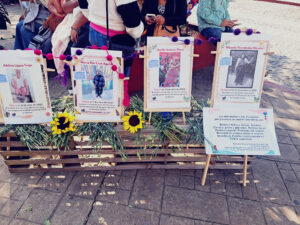
Event of mothers searching their missing family members, San Cristóbal de las Casas, May 2025 © SIPAZ
In March, demonstrations took place across the country as part of the national mourning for the disappeared after the discovery of the “extermination” center in Teuchitlán, Jalisco. The site, allegedly used by the Jalisco New Generation Cartel (CJNG) to dispose of bodies and train recruits, was initially inspected by the National Guard in 2024, but the investigation was incomplete. The ranch was “rediscovered” on March 5th by the Guerreros Buscadores collective of Jalisco following an anonymous tip. Members of the collective found cremation ovens, human remains, and various personal items such as shoes, backpacks, and clothing. A suspected survivor of the Izaguirre ranch revealed that people who did not comply with orders or were considered weak were killed.
In the 2024 National Guard operation, ten people were arrested. However, the National Guard members did not see a single one of the 1,300 objects found so far. Evidence shows that the remains were already there at the time of their inspection by the Jalisco Prosecutor’s Office. The Attorney General’s Office confirmed that the state prosecutor’s office committed multiple omissions in its investigation.
Claudia Sheinbaum reacted to the case by urging caution before drawing conclusions. She was criticized for downplaying the number of disappearances and for pursuing an approach that marginalizes groups of mothers of the disappeared. Her strategy appears to seek to prevent the case from becoming a major political scandal, similar to that of Ayotzinapa, and to minimize the government’s responsibility for the disappearance crisis.
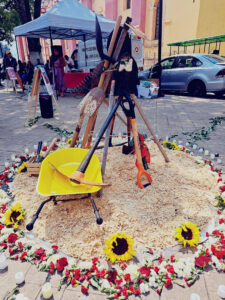
Altar in honor of mothers searching their missing family members, San Cristóbal de las Casas, May 2025 © SIPAZ
In April, the UN Committee on Enforced Disappearances (CED) activated Article 34 of the Convention against Enforced Disappearances for the first time in history, requesting urgent information from Mexico and opening the door to intervention by the UN General Assembly. The article states that “if the Committee receives information that, in its opinion, contains well-founded indications that enforced disappearance is practiced on a widespread or systematic basis in the territory under the jurisdiction of a State Party, and after having requested all relevant information on this situation from the State Party concerned, it may bring the matter urgently to the attention of the United Nations General Assembly.” Olivier de Frouville, president of the Committee, emphasized that Mexico is in a “worrying situation” and, consequently, it was deemed necessary to take precautionary measures.
Sheinbaum denied the existence of enforced disappearances from the State and identified disappearances as a phenomenon related to organized crime, while the government is doing everything possible to combat it. The president of the Senate’s Board of Directors, Gerardo Fernández Noroña, also criticized the president of the UN Committee and announced that they will demand sanctions against the official.
The following day, relatives of missing persons and search groups symbolically closed the Senate headquarters in Mexico City. “Closed due to lack of commitment to the families of missing persons” or “Denying and Hiding is Disappearing 127,000+ Missing” could be read on the vinyl signs hanging on the fences surrounding the Senate. They also reported that family members searching for their loved ones have also become targets of threats and attacks, with at least 27 people murdered since 2010. Three more searchers are missing.
Human Rights Defenders and Journalists: Sectors at Risk
In April, Article 19 presented the report “Information Barriers: Challenges to Freedom of Expression and Access to Information,” which exposes the main obstacles facing Mexico in terms of freedom of expression, access to information, and violence against the press. It documented that 639 attacks against the press were recorded in 2024, including five murdered journalists. It reported that this number represents a 13.9% increase compared to 2023 and is equivalent to one attack every 14 hours. It lamented that, despite the seriousness of the situation, “last year the Special Prosecutor’s Office for Crimes Committed against Freedom of Expression (FEADLE) only received 84 investigations.” The organization also warned about the rise of judicial harassment as a method of censorship. The Mexican state remained the main aggressor (44.91% of the total).
In April, the Mexican Center for Environmental Law (CEMDA) presented its eleventh Report on the Situation of Individuals and Communities Defending Environmental Human Rights in Mexico, reporting that 25 environmental and territorial defenders were murdered in 2024. Forty-five percent were Indigenous peoples. During the last five years of Andrés Manuel López Obrador’s administration and the first three months of Claudia Sheinbaum’s, from 2020 to 2024, 1,428 attacks on environmental defenders were recorded, including 189 homicides. The report also documents the increasing involvement of authorities as perpetrators of these attacks. The states with the highest rates of violence were Oaxaca, Mexico City, and Chiapas.
CHIAPAS: “We have built peace, now we are moving towards development and progress,” ERA
On March 15th, in Tapachula, the government report for the first 100 days of Eduardo Ramírez Aguilar’s (ERA) administration was held, titled “100 Days of Living in Peace.” During his speech, he highlighted the issues of security and megaprojects. Regarding security, he stated that Chiapas is the second safest state in the country and that the President of the Republic even recognized the security strategy implemented and invited him to a meeting with other governors to discuss ways to replicate this model. Businesspeople and producers in Chiapas stated that they had noticed “a change in the first few days; there were operations and increased surveillance, but crime is still there. As long as that happens, the economy will remain stagnant.”
The Fray Bartolomé de las Casas Center for Human Rights (Frayba), in the framework of its 36th anniversary, declared: “It is important to insist that there will be no peace until armed groups linked to organized crime, linked to power groups that have been rooted for decades in the state of Chiapas, are dismantled, prosecuted, and disarmed. (…) Peace is not a pause or respite with fewer confrontations; it is about building processes of justice.”
Among ERA’s priority economic projects: the San Cristóbal-Palenque Highway
In February, in Bachajón, Chilón municipality, Governor Eduardo Ramírez Aguilar participated in the Public Consultation for the construction of the Palenque-Ocosingo Highway, a project that was approved “unanimously” by the ejidos present.
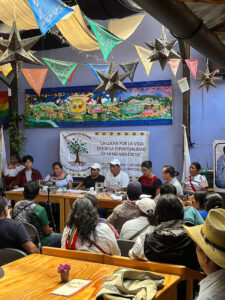
Press conference of MODEVITE and the community government of Chilón, San Cristóbal de las Casas, April 2025 © SIPAZ
Later, the Movement in Defense of Life and Territory (MODEVITE), made up of Tseltal, Tsotsil, and Chol people from 13 municipalities in the Highlands and Jungle regions of Chiapas, expressed their opposition to the highway: “We do not want any more destruction of Mother Earth and our culture. Today we are once again demonstrating against a project that seeks to strip us of our territories rich in water, trees, and vast natural resources. A project that hides the same old story: colonialism, racism, and favoring the interests of large transnational corporations, extractive companies, drug traffickers, and the government.”
For its part, the community government of Chilón reported that “some communities have received threats from engineers taking soil samples, warning that if they do not allow it, they will be accompanied the next time” by agents of the Pakal Immediate Reaction Force (FRIP), “thus generating fear and dread in the population.” It also stated that the project “has been rife with irregularities and violations of our rights as indigenous peoples, as they have conducted soil studies without our consent and without prior information about why and for what purpose it will be used.” It added that “some of the community authorities, who are the voice of the people, are actually making their own decisions without consulting the communities, and they are not submitting reports on the highway construction process, thereby violating the internal regulations of our ejidos.” It clarified that “we are not against progress; as Indigenous peoples, we understand and believe in lekil kuxlejal (good living), which is not possible by trampling on us, destroying and dispossessing us of our territory.”
In March, a public consultation called “The Highway is Ours, the Route of the Maya Cultures” was organized by the government in the municipalities of Palenque, Ocosingo, Chilón, Salto de Agua, and Tumbalá. Authorities reported that, with more than 39,000 votes in favor, the construction of the first section of the San Cristóbal-Palenque Highway was approved. It is important to emphasize that this was a public and not an Indigenous consultation, with the requirements that this entailed.
In response, members of MODEVITE and the Community Government of the municipality of Chilón expressed their rejection of the project, as well as of the popular consultations. They reported that they filed two injunctions due to legal loopholes in the right to consultation and the lack of public information about the project itself. They pointed out that the communities that will be directly affected by the highway were not consulted, and that the majority of those who voted were residents of the municipal capitals.
Pilgrimages, Complaints, Events, and Other Organizational Efforts
From April 13th to 19th, the Zapatista Army of National Liberation (EZLN) hosted a gathering of art, rebellion, and resistance. It began in the Jacinto Canek caracol (the official municipality of Tenejapa) and then at the CIDECI Uni-Tierra facilities in San Cristóbal de las Casas.
More than 1,000 artists from 28 different locations participated, presenting various art forms such as dance, singing, circus, and crafts, among others. At the closing event, Sub-commander Moisés denounced the presence of agents from the National Guard and the Pakal Immediate Reaction Force (FRIP) outside the CIDECI Uni-Tierra facilities.
In May, after several national and international mobilizations, two EZLN support bases, José Baldemar Sántiz Sántiz and Andrés Manuel Sántiz Gómez, were released. They had been detained on April 24th in the municipality of Aldama. The EZLN published: “This achievement of the release of our two innocent compañeros was the result of a triple effort: that of human rights defenders, that of national and international solidarity and support, and that of the autonomous justice system.”
In April, both the Network for the Rights of Children and Adolescents in Chiapas (REDIAS) and the Community Feminist Pronouncement denounced the femicide of two Tsotsil women, ages 14 and 18, whose bodies were found in San Juan Chamula. They affirmed that it was a femicide and categorically rejected the position of the State Attorney General’s Office, which has referred to it as a “crime of passion.” They considered that these types of classifications revictimize victims and ignore gender-based violence as a structural cause of murder. They reported that, during the first three months of the year, 452 investigation files were reported for crimes against women, including seven homicides, four attempted homicides, four femicides, and four attempted femicides.
In May, as part of the commemoration of the first anniversary of the massacre of 11 people by criminal groups in the Nuevo Morelia ejido in Chicomuselo, a pilgrimage was held with the victims’ families and more than a thousand members of the Diocese of San Cristóbal. A statement emphasized: “We are living through difficult times with great pain, indignation, and helplessness in the face of the reality of the violence we have suffered and continue to be victims of. For many years, we have been denouncing the wave of injustices, violations of our human and collective rights, and the plundering of mining materials, and we have never been heard.” “Our voices were silenced by weapons, we were forced to act as a human barrier during clashes between criminal groups, we were beaten by those who were supposed to guarantee the security of our people, we were forced to flee our communities to save our lives, we returned, not because there were security conditions guaranteed by the state, but for fear of losing our heritage,” they added. “Much has been said about peace having come to our people, but from our faith and our hope, we know that peace is not just a word, but rather springs from justice (…) as the people of Chiapas, we need true peace, which is not synonymous with militarization, a peace where people can be free from violence, threats and intimidation, where the rule of law is restored for each and every one,” they pointed out.
OAXACA: One of the States with Most Attacks against Human Rights Defenders
In February, the Union of Indigenous Communities of the Northern Zone of the Isthmus (UCIZONI) announced the temporary closure of its offices due to threats and the climate of violence prevailing against its lawyers in the region. This followed the ambush of three people who were murdered on February 13th during the agrarian conflict between Santo Domingo Petapa and San Juan Mazatlán Mixe. It also demanded an end to the stigmatization campaigns against their work in defense of human rights.
Likewise, in February, Cristino Castro Perea was murdered in Barra de la Cruz. The Office of the United Nations High Commissioner for Human Rights (UNHCHR) highlighted that since 2023, his collective “Environmental Defenders of Barra de la Cruz” has been a beneficiary of the Federal Protection Mechanism for Human Rights Defenders and Journalists. She called on authorities to guarantee the protection of the collective’s members, as well as to conduct a prompt and effective investigation. Castro’s murder is not the first attack against defenders in the area: in 2021, community leader José Castillo Castro was also attacked; and in 2018, Noel Castillo Aguilar of the Committee for the Defense of Indigenous Rights (CODEDI) was murdered. Both crimes remain unpunished.
In March, Zapotec defender Silvia Pérez Yescas reported multiple attacks and threats by local armed groups. Likewise, the founder of “Indigenous Women for the Conservation, Research, and Use of Natural Resources” (CIARENA) reported that the organization remains closed for the same reason.
In April, the bodies of Mixe Indigenous activist Sandra Estefana Domínguez Martínez and her husband, Alexander Hernández Hernández, were found in Veracruz. They had been missing since October 2024, shortly after Sandra reported Oaxaca government officials for gender-based violence against Ayuuk Indigenous women. Following the news, Sandra’s relatives and supporting organizations declared, “After 206 days of anguish, endless nights, and a tireless struggle to demand her return, today with a broken heart, we confirm that we have found Sandra. (…) She will always be recognized as a tireless defender. As an Ayuuk woman, she embraced the defense of her people and all Indigenous women who suffered violence or discrimination.”
Similarly, in April, Emelia Ortiz García, a member of the Unifying Movement of Triqui Struggle (MULT), reported that her home had been raided and evidence of cases of violence, as well as personal belongings, had been stolen. She highlighted that on two other occasions, unknown individuals entered the places where she keeps her belongings, stealing documentation related to cases of murdered or missing members of the MULT.
Also in April, more than 20 national and international organizations demonstrated to demand an end to the harassment and criminalization of 24 members of the Ayuujk and Binizaa communities, who oppose the imposition of the Isthmus of Tehuantepec Interoceanic Corridor. “Given the lack of attention to their demands, they have taken legitimate actions to defend their territories and life projects, which is why today they face unfair judicial processes that seek to silence their resistance,” they said.
In April, the Second Forum in Defense of Territory and Social Property in Oaxaca was held in Santa María Atzompa, with the participation of representatives from 30 social organizations and 72 communities. They denounced that “the Second Floor of the Fourth Transformation operates with a double standard. On the one hand, it speaks of development and well-being for the people, when in reality it has only deepened the advance of industrial development for extractive purposes.” They added that “we are experiencing open-air plunder where legality is combined with the violence of organized crime.”
GUERRERO: “Unstoppable Violence, Untouched Impunity”
In April, Marco Antonio Suástegui, leader of the Council of Ejidos and Communities Opposed to the La Parota Dam (CECOP), was injured after a man shot him in Acapulco. He died a few days later from his injuries.
“The murder of Marco Antonio Suástegui Muñoz is a disastrous event for the social movement in Guerrero and a wake-up call for the social activists who are in the trenches fighting to defend the rights of the forgotten and persecuted population of our state. This context of violence that engulfs our state and has placed us hostage to crime is a serious indicator of the breakdown of state institutions and the capitulation of authorities who have lowered their guard to uphold the rule of law,” stated the Tlachinollan Human Rights Center in the bulletin “Unstoppable Violence, Untouched Impunity.” Shortly after, Samantha Valeria Colón Morales, wife of the disappeared activist Vicente Suástegui, reported death threats following the murder of her brother-in-law, Marco Antonio Suástegui. She was told that her husband, Vicente, had already been disappeared, that Marco Antonio had already been murdered, and that she would be the next victim.
In another struggle to defend land and territory, tension has resurfaced in recent weeks between the people of Carrizalillo and the mining company Equinox Gold, the third transnational company to extract gold during the 20 years of mining in this area. According to the ejido, this measure seeks to pressure the community into signing a new occupation agreement, which would reduce rent payments by 65% and eliminate social benefits, including support for the purchase of medicines for people sickened by air pollution and other factors resulting from mining exploitation. The ejido (community) asked the company to “expeditiously begin the process of restoring and rehabilitating our lands, flora and fauna, and the mitigation measures required to contain the increase in emissions and environmental damage, all in accordance with the regulatory framework.”
Nearly 100 organizations from Canada, more than 66 networks and organizations from Mexico, and another 31 from 12 countries sent a letter to Equinox Gold expressing their concern about the threats, violence, and legal persecution directed at the Carrizalillo community in the context of the renegotiation of the lease agreement. They stated that “Guerrero state officials have participated in the pressure tactics and imposition of the agreement, failing to protect the community’s rights.”
In the context of International Women’s Day (8M), thousands of women marched in Guerrero to demand an end to violence and femicides. According to the Guerrero Association against Violence against Women, from 2022 to 2025, 432 homicides against women were committed in the state. In the case of La Montaña, Tlachinollan stated that “municipal, state, and federal authorities are not interested in violence against women. Tlachinollan has recorded 130 femicides from 2006 to 2025, but the institutions have not conducted investigations. On the contrary, they have denied justice to the victims. The killers walk free, with complete impunity.”

